
Monolithic Stelae at Aksum. (752k)
Aksum was the original capital of the Kingdom of Aksum. It is one of the oldest continuously inhabited places in Africa. Aksum is a UNESCO World Heritage Site.
Aksum was a naval and trading power that ruled the region from about 400 BCE into the 10th century. Around 356 CE, its ruler was converted to Christianity by Frumentius. Later, under the reign of Kaleb, Aksum was a quasi-ally of Byzantium against the Persian Empire.
One of the interesting sites in Aksum are the Aksum Stelae, 1700 year old monolithic obelisks. They were built before Christianity came to Ethiopia. The largest one (33 m (108 ft) long, 520 tons) fell and broke during construction. The largest standing stele is 24 m (79 ft) tall, weighing 170 tonnes. It was taken by Mussolini in 1937 and brought to Italy. In a 1947 UN agreement, Italy agreed to return the stele to Ethiopia, along with the other looted piece, the Lion of Judah. It was not till 2005 that the stele was returned. It was re-erected and unveiled in 2008.
Another attraction is the Church of Our Lady Mary of Zion. It dates back to the 4th century to Saint Frumentius, who brought Christianity to Ethiopia. It has been rebuilt several times over the centuries. The current building dates back to the 1950s. On its grounds is the Chapel of the Tablet, said to hold the Arc of the Covenant with the tablets of the 10 Commandments given to Moses. The Arc of the Covenant, according to Ethiopian history was stolen from Jerusalem by the son of King Solomon and the Queen of Sheba and brought to Ethiopia. It was kept in a monastery on the Zege peninsula in Lake Tana for 400 years, before it was brought to Aksum. It is now said to be in the Chapel of the Tablet on the grounds of the Church of Our Lady Mary of Zion.
Another interesting monument is the Ezana Stone with inscriptions in three different languages (Greek, Ge'ez, and Sabaean), similar to the Rosetta Stone.
The Queen of Sheba Palace is not really associated with the Queen of Sheba. It dates from 600-700 CE. Near this palace are many standing stones. They all mark graves. They date from the 1st century BCE to 1st century CE.
There are many other sites that are 1500 to 2000 years old. Most of Aksum is built on old ruins. In order to excavate them people would have to be relocated.
All pictures are © Dr. Günther Eichhorn, unless otherwise noted.

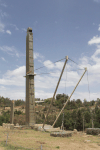
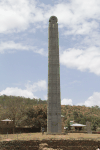
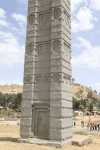
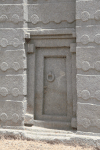





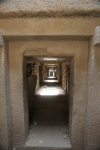
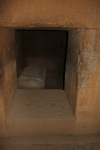


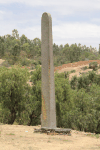
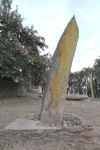






On a small hill 1.8 km (1.1 miles) northeast of the Northern Stelae Field are the twin mausoleums of King Kaleb and his son King Gebre Meskel. They date from the 6th century. However, the assignment to King Kaleb and his son King Gebre Meskel may be more legend than fact.
Although the twin tombs' architecture resembles the Tomb of the False Door, they show more sophistication, using irregular-shaped, self-locking stones that don't require iron clamps.
Near the tombs is the cross shaped entrance to underground tunnels. Legend has it that the tunnel goes 185 km (115 miles) to the Red Sea.


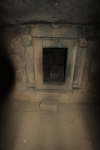

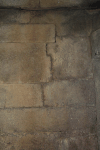



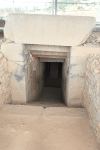







The Ezana stone is an artifact from the ancient Kingdom of Aksum. It was discovered only in 1982. It is a stone monument which documents the conversion of King Ezana to Christianity and his subjugation of various neighboring areas, including Meroé. It talks about the extent of the kingdom and about tributes to the king.
From CE 330 to 356, King Ezana ruled the ancient Kingdom of Aksum centered in the Horn of Africa. He fought against the Nubians, and commemorated his victories on stone tablets written in Ge'ez (the ancient Eritrean/Ethiopian language), Sabaean (South Arabian) and Greek in praise of God. His carvings in stone provided a trilingual monument in different languages, similar to the Rosetta stone.
It is one of the few ancient written records to come from pre-Islamic Africa.
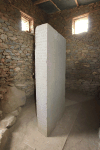
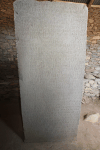

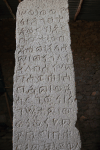
The Church of Our Lady Mary of Zion is the most important church in Ethiopia, and claims to contain the Ark of the Covenant. It is located in the town of Aksum in the Tigray Province. The original church is believed to have been built during the reign of Ezana, the first Christian ruler of the Kingdom of Aksum (Present-day Eritrea and Ethiopia), during the 4th century CE, and has been rebuilt several times since then. The current cathedral was built by Emperor Haile Selassie in the 1950s.
St. Mary of Zion claims to contain the original Ark of the Covenant. Reportedly, the Ark was moved to the Chapel of the Tablet adjacent to the old church because a divine "heat" from the Tablets had cracked the stones of its previous sanctum. Emperor Haile Selassie's wife, Empress Menen, paid for the construction of the new chapel.
According to tradition, the Ark came to Ethiopia with Menelik I after he visited his father King Solomon. Only the guardian monk may view the Ark, in accordance with the Biblical accounts of the dangers of doing so for non-Kohanim. This lack of accessibility, and questions about the account as a whole, has led foreign scholars to express doubt about the veracity of the claim. The guardian monk is appointed for life by his predecessor before the predecessor dies. If the incumbent guardian dies without naming a successor, then the monks of the monastery hold an election to select the new guardian. The guardian then is confined to the chapel of the Ark of the Covenant for the rest of his life, praying before it and offering incense.

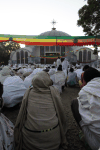





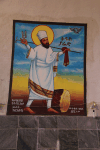
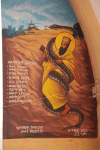







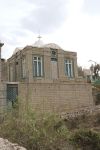

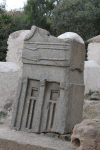


The Queen of Sheba Palace is not really associated with the Queen of Sheba. It is from about 600 - 700 CE. The palace is about 50 x 35 m (160 x 115 ft). It has about 50 rooms. Most of the rooms on the ground floor do not have doors, they can only be accessed from the floor above. The round structures in some of the rooms are supports for columns in the floor above. There are brick ovens for baking in the palace. Each house has a small oven for baking bread for the inhabitants. The granite stairs are original. The palace was excavated in 1965 by French archaeologists. It has older structures underneath, so this site has been inhabited much longer. There are other structures around the palace that have not been excavated.
The small standing stones around the area all mark graves. They are from the 1st century BCE to the 1st century CE. The mountain behind the palace is the quarry place for all the stelae and stones in Aksum.







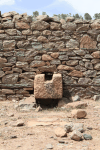
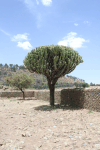

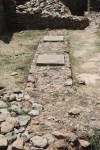





This page contains 79 pictures

Main page for ኢትዮጵያ (Ethiopia)
Page last updated on Tue Sep 24 18:19:03 2019 (Mountain Standard Time)
Architecture in Aksum on soaring.geichhorn.com